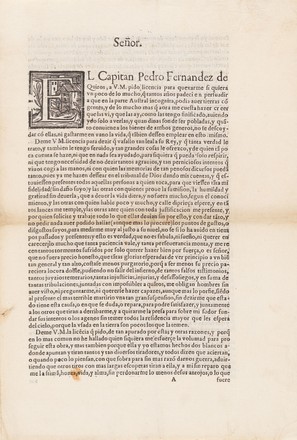Señor. El Capitan Pedro Fernandez de Quiros, a V.M. pido licencia para quexarme si quiera vn poco de lo mucho ...
1614
SAFE 1/5r
Block print on laid paper
In this memorial Pedro Fernandes de Queirós (1563–1615) uses highly emotive language, conveying the passion he has for his quest to return to Austrialia del Espiritu Santo.
He begs Spain’s King Philip III to respond to his repeated requests to support a missionary expedition and relates his difficulties in persuading the Spanish authorities to send another expedition:
‘… Here I am in need of having to argue and to write as a great theologian, canonist and philosopher, being only a mere sailor and soldier. And I also ask, who are those who shall bear God's justice, so many souls, and so many assets that are lost each day in all those provinces, in whose name, and of its peoples ...’
With a government severely starved of funds, the King had no real intention of funding another expedition but finally dispatched Queirós to Peru in 1614 with hollow promises. Unfortunately Queirós died on the voyage and no further attempts were made by the Spanish to explore the South Pacific.
Captain James Cook eventually charted the great southern
continent imagined by Pedro Fernandes de Queirós and actually sighted by Torres.
Pedro Fernandes de Queirós’ 1605–6 voyage was Spain’s
last major attempt to explore the South Pacific as the Spanish government was
severely constrained for funds and none of the anticipated results of new
sources of wealth, new colonies or converts to Catholicism were achieved.
In 1959, the poet James McAuley began work on his epic poem, Captain Quiros (published 1964), which many regard as the summation of his life’s work, both as a writer and as a Catholic. McAuley imagined the ships of Pedro Fernandes de Queirós riding ‘in upon the present from the past’, inspiring a vision of faith that would transform Australian society in the future. James McAuley had read the Queirós memorials held by the State Library of NSW.
Copy prints appeared throughout Europe after the leaking of one of Pedro Fernandes de Queirós' original memorials.
There is a street named Rua Pedro Fernandes de Queirós in the district of Bairro do Restelo, Lisbon, Portugal.
The voyages of Pedro Fernandes de Queirós and Luis Vaez de Torres resulted in the discovery of thirteen coral islands in the Pacific, the Duff and Banks groups (Solomon Islands), the New Hebrides (Vanuatu), the eastern end and southern coast of New Guinea, and the Torres Strait with its innumerable islands.
If Pedro Fernandes de Queirós had continued with his original plan to sail WSW from Callao, Peru until he reached latitude 30˚S, he would have discovered New Zealand.



 Back to list
Back to list